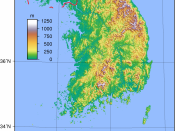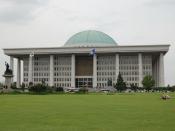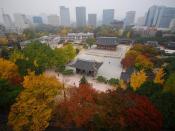I was having a hard go at trying to figure out what I wanted to write this report about. I knew that in order for me to get totally involved in my research I would need to find a topic that was both factual and stimulating. It dawned on me that my subject was the environment of the country that I am serving in. Always assuming what causes the ever-present pollution in South Korea, I realized that there was much that I did not know about why this country's environment is in the sad state of ecological despair that it is in.
First I'd like to present a geographical tour of this country. South Korea is the southern portion of a small peninsula that juts southward from Mainland China into the East China Sea. It is a mountainous country. Lowlands, located primarily in the west and southeast, make up only 30 percent of the total land area.
South Korea can be divided into three general regions; High mountain ranges and narrow coastal plains in the east, broad coastal plains, river basins, and rolling hills in the west, and a southern region where a maze of mountains sit in the west and the broad basin of the Naktong River in the southeast. Halla-san is an extinct volcano that forms Cheju Island south of the mainland, which is the country's highest point at 6,398 feet. The T'aebaek range forms South Korea's principal mountain system. It extends generally north-south parallel to the eastern coast. Four other mountain ranges extend from the T'aebaek range, including the Sobaek range, the country's second largest mountain system. The highest peak of the mainland, Chiri-san at 6,283 feet, rises in the southern portion of the Sobaek range. The mainland has no volcanic activity, and earthquakes are rare.
The major rivers of South Korea flow generally east to west, where they empty into the Yellow Sea, or north to south, where they empty into the Korea Strait. The two longest rivers are the Han and the Naktong, both originating in the T'aebaek range and each flowing more than 300 miles. The Han flows northwest to the Yellow Sea, passing through Seoul, the country's largest city and the third largest city in the world! The Naktong flows south and empties into the Korea Strait at Pusan, the country's principal port. The extensive river basins of these rivers are the most densely populated and extensively cultivated areas of the country.
The coast of South Korea is about 1,500 miles long and forms all but the northern border. In the west and south, the coast consists of many peninsulas and natural harbors, but is fairly smooth in the east. The eastern coast is much higher in elevation overall than the western coast. Movements of Earth's crust are slowly uplifting the eastern side of the Korean Peninsula. The tides between high and low can be up to 30 feet! I am originally from northeastern Maine and have visited the Bay of Fundy many times, which has extreme tidal ranges similar to South Korea's. Also, about 3,000 islands, most of them small and uninhabited, lie off the western and southern coasts.
South Korea has a temperate climate with four distinct seasons. Winters are cold and windy with snow in most areas except for the most southern regions. Summers are hot, humid, and rainy. The Asian monsoon brings frigid air from the Artic in winter and warm, moist air from the South China Sea in summer. Most of the rain occurs in the summer months and the southern coast is subject to late summer typhoons that bring strong winds and heavy rains. I have been in no other place that receives the amount of summer time rainfall as South Korea. In 1998 many buildings and structures here at Camp Casey were destroyed because of torrential rains and flooding.
Mixed deciduous and coniferous forests cover about three-quarters of the land. Most of the country's old growth forests were cleared during Japanese rule for use as firewood and building materials. The country's few remaining old growth forests are protected in nature reserves. The majority of forests are made up of small scrubby maples, elms, and pines.
In contrast to North Korea, South Korea is relatively poor in mineral resources. The principle resources are coal, iron ore, and graphite. Other minerals include zinc, tungsten, lead, copper, gold, and silver. Limestone is quite abundant which I suspect is why I come across quite a bit of marble here.
The major beginning of South Korea's ecological demise began as recently as the early part of the last century. In 1910, Japan began its rule of Korea until it's defeat in 1945 during World War II. Japan's rule was the beginning of Korea's modern economic infrastructure. They built the first modern factories and brought modern communications and transportation systems to this small country. America assisted South Korea after the signing of the 1953 armistice with economic growth and modernization of heavy industry in order to build security against North Korea's economic strength, which was fueled by the Soviet Union and Big Brother China. This rapid economic growth resulted in the current ecological problems that exist in this country today.
During the 1960's and 1970's, Korea's economic policy focused on rapid growth through industrialization. This gave rise to various economic problems mainly because the equality between economic success and environmental protection was neglected. When pollution became serious in the 1970's, the government decided to get serious about pollution issues and in 1990 the Ministry of Environment was established. The government worked hard to improve water and air quality and also waste management, which achieved remarkable results. However, this has been to little to late as South Korea is still ravished by serious pollution.
Unchecked industrial development has been the sole ambition of Korean policy over the last three or more decades. Environmental concerns were aggressively eliminated by whatever means necessary. The effects of this rapid industrialization and environmental neglect have horrifically left its mark on this land. Environmentally associated diseases such as cancer are rising dramatically as a result of this severe problem.
So what are the major culprits? Extremely rapid population growth in South Korea's major cities has in turn increased the number of private and public transportation modes tenfold. Thirty-five years ago, owning a personal automobile was a great luxury. Today there are over ten million cars in this compact country, which contribute significantly to its severe air pollution. A good example of this over abundance of automobiles is braving the commute from my installation, Camp Casey to the city of Seoul, about thirty miles to the south. This drive takes over two hours on a good day because of the congestion and lack of what we know as good expressway systems. This is to merely make it to the northern boundary of Seoul! Another reason for all this pollution is in the fact the South Koreans burn everything. From burning off farmlands and rice paddy's in the winter to the daily burning of solid wastes, this place is SMOKEY. Breathing in this country is like trying to breath in a crowded barroom albeit much more pungent. Americans make a big stink about second hand cigarette smoke that affects them on occasion; here, the smoke is a daily part of living, and depending on the prevailing winds and / or lack of precipitation, this air pollution can be quite concentrated. The smog level of Seoul is just slightly less than that of Mexico City, which is known to have the highest levels in the world! Now imagine the entire country under this smoky, hazy siege! The extremely mountainous terrain of this region seems to have the effect of holding in pollution. It has nowhere to go but up. Add some heavy air, and yesterday's smoke is still here today, not to mention the smoke produced today. These high levels of air pollution have produced serious acid rain problems also.
South Korea is not the only area, which is causing air pollution. Japan is trying to prove that China is responsible for Northeast Asia's acid rain and is trying to encourage the country to install sulfur oxide trapping equipment in its coal burning factories. Both South Korea and Japan have started joint initiatives toward improving air pollution. However, East Asia's acid rain problems are still worsening at a serious pace. Lack of cooperation among other countries in the region has made it difficult to pinpoint its causes, with no country taking responsibility. The South Korean government is imposing new regulations on industry by tightening controls on air pollution and sulfur oxide emissions; however, the rapid industrialization growth is preventing the government from effectively managing these regulations.
South Korea's acidic soil and water resources in addition to industrial development have either eliminated or severely reduced the amount of habitat available for animals. More than one hundred animal species have disappeared in only 40 years! I spend a good deal of time atop area mountains to perform my mission here. Of a combined total of about 30 days atop these forested hilltops, I have seen exactly two chipmunks, one rodent suspiciously resembling a small rabbit, and several birds. In comparison to my numerous treks in the Fort Benning wilderness with its abundant wildlife, this is an extremely eerie observation.
Air pollution is the most visible environmental problem here but water pollution is the most critical. South Korea has 600 water sources, half of which are dams or main rivers. All the major rivers, which are the major source of drinking water, are of second rate or poorer quality. They are polluted by industrial, household, and agricultural activities, including livestock raising. Recently, resort areas, which are usually located at the upstream areas of rivers, have aggravated this situation. There are grave concerns about the contamination of tap water with toxic heavy metals. The tributaries near rapidly growing population centers are so contaminated that their water cannot even be used for industrial purposes! The water quality of the Han River, the water supply source for Seoul, is a major concern. Due to the huge population concentration in this region, the Han River is heavily polluted there and the fish population disappeared long ago. Several sewage treatment plants were opened in the late 1980's, which improved this problem, somewhat but there are still problems due to the lack of a separate sewer system overflow of storm water into wastewater. Most Koreans rely on bottled water because of the lack of sufficient sewage treatment facilities, thus limiting clean tap water. Until recently, most, if not all of Korea's sewer system, especially in more rural areas, were of the open sewer type. Everything runs into these on the way to the land's waterways and eventually to the sea unaltered because of this lack of good sewage treatment means. The number of fish species off the coast has declined from 141 to only 24 in recent years, a direct result of contamination of near shore sediments and also rising levels of heat pollution from power plants and industrial activities. Improper storage, handling, and disposal of industrial chemicals like solvents and dyes have significantly contaminated soil and groundwater. In rural areas, heavy use of chemical pesticides, fertilizers, and herbicides plus uncontrolled runoff from cow and pig farms has caused horrible damage to the soils and aquifers.
The generation of solid wastes in South Korea per capita is among the highest in the world yet the country's solid waste disposal capacity is limited. The total volume of waste is steadily rising due to population increase and a strengthening economy. This huge mass of solid waste production is swamping the country's landfill capacity and has created a significant illegal dumping problem. A drive along practically any roadway in the country proves this fact. There is trash everywhere from the roadside to the streams and rivers. A walk through a local village is also proof positive that solid waste is disposed of haphazardly and by any convenient means. The unfortunate result of this all to common practice is that hazardous chemical and animal wastes, industrial byproducts, and domestic wastes are freely commingled and unmanaged in both urban and rural areas.
Why does it seem so difficult for South Korea to surpass its pollution producing capacity with environmental regulations that clean up the country's environment? The people here have changed very little in hundreds of years. Theirs is a tradition steeped in customs that haven't really changed since ancient times. Americans seem to adapt to change fairly readily, while South Koreans do not. As a result, work ethics and concern for the environment have not fluctuated much as compared to America. Things are trying to change. Fines are imposed for industries that contaminate the land, water, and atmosphere, but, as is the case in Atlanta, the cost of purchasing the equipment and personnel to update pollution-causing sources is in many cases steeper than it is to simply pay a fine for not conforming.
In my opinion, and many others, South Korea needs to stiffen the penalty for this environmental negligence and hold the offenders responsible for the costs of cleaning it up or what is today a beautiful and rugged country will no longer be inhabitable by humans, as many of its other creatures have discovered already.


